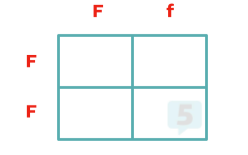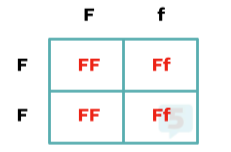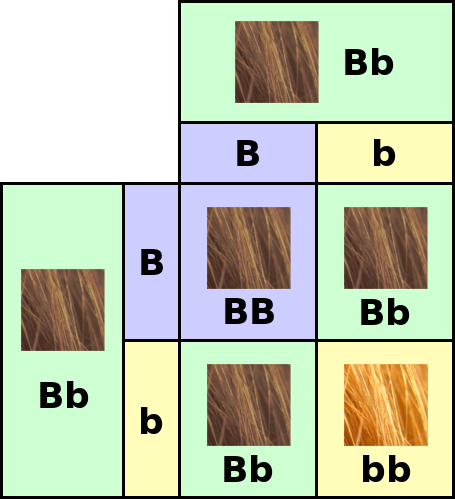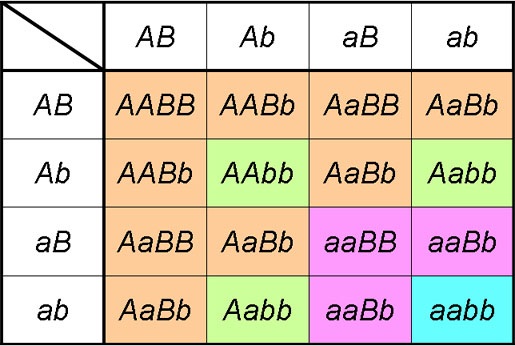Sitara H
Biology 🧍
13 resourcesSee Units
Plotting Genotypes to Predict the Potential Phenotypes of Genetic Crosses.
One of the main benefits of studying genetics is recognizing the likelihood of passing on specific traits to one’s offspring: eye color, height, you name it. 📏
Why does this matter? Genetics can help people predict patterns of inheritance, as well as helping plant and animal breeders develop more desirable qualities in the type of populations they raise, for example! 🐖
Genetics Mini-Glossary: Key Terms & Words 👌
☝ Alleles
Before diving deeper into Punnett Squares, let's first look into the building blocks of genetics: genes. Most sources define them as "basic physical and functional units of heredity." 🧬
To be more specific, genes come in alleles or different versions. A dominant allele masks a recessive allele and will determine something about an organism's appearance. 🌈
- For example, suppose you have a recessive allele corresponding to blue eyes and a dominant allele corresponding to brown eyes. In that case, you'll most likely have brown eyes due to the dominant allele masking the blue-eyes recessive allele. 🟤
🎀 Law of Segregation
The Law of Segregation, one of Gregor Mendel's Laws of Inheritance, emphasizes that each gamete randomly receives a copy of an allele when an organism makes gametes. 🙌
This way, an organism's offspring has a random chance of getting either part of its parent's genotype. Randomness, in turn, helps increase genetic diversity within a population. Otherwise, the population will be wiped off by environmental pressure, and there would be much, much fewer survivors. 🔥
❌ Genotype & Phenotype
We use Punnett Squares to predict an organism's offspring's genotypes (allele combinations) using genetic crosses. By knowing the genotypes, we can then determine phenotype (physical appearance). 🔮
When an organism has two copies of the same allele (YY or yy), it is homozygous—homozygous dominant (YY) or homozygous recessive (yy)—for that allele. If it has two different copies of the gene instead (Yy), it is heterozygous. ❗
The dominant allele will mask the recessive allele for heterozygous organisms. In other words, the organism will still have a dominant phenotype despite its heterozygous genotype. 🎭
💡 Note: When denoting alleles, capital letters (ABCD) are used for dominant traits, and lowercase letters (abcd) are used for recessive ones!
Creating the Punnett Square 📝
Preparing a Punnett Square is quite simple! First, we put the genotypes of both the parents across the top and side of the square. 🤔

Then, we place all the possible combinations of the alleles into the smaller boxes. 📦

Because each box represents an equally likely event, we can determine the ratio of possible genotypes and phenotypes by counting the squares. Since each gamete is similarly common, each fertilization event (each test combination present in one of the smaller squares) has an equal chance of happening as well. 🥚
Monohybrid crosses (1️⃣)are when Punnett squares like those above and below are tailored for just one specific gene, while dihybrid crosses (2️⃣) are for two genes.
1️⃣ Monohybrid Crosses
For example, brown hair in humans is a dominant allele (B) for the hair color gene, and blonde hair is a recessive allele (b). Both parents in the case study below have heterozygous genotypes (Bb), but both have brown hair because it masks their recessive blonde gene. 👱♂️
When all four fertilization events are displayed, we can see the 1:2:1 genotype ratio of the chances of homozygous dominant (BB), heterozygous (Bb), and homozygous recessive (bb) offspring. However, the phenotype ratio looks slightly different, with a 3:1 ratio instead of brown to blonde hair. Only the homozygous recessive offspring (bb) of these two brown-haired humans will have blonde hair, with all others having brown hair just like their parents! 😄

Image courtesy of Wikimedia
2️⃣ Dihybrid Crosses
Dihybrid crosses work the same way as monohybrid ones do; it's just that this time, we're working with two traits! 😳
However, there is a slight difference in how you line up the traits on the square's edge. Instead of just putting each letter for the parent's allele by itself, you take all the possible combinations of the four alleles (mix and match!) that the parent has and put those along the edge instead. Then, you can test each fertilization event like normal by crossing the alleles. ✅
Check out the example below!

Image courtesy of Wikimedia
For example, take tall trees (A) to be dominant to short trees (a) and light green leaves (B) to be dominant to dark green leaves (b). The above dihybrid Punnett square shows all of the possible fertilization events between two heterozygous trees for both genes and are therefore both tall and have light green leaves. 🌳
We can also read this 9:3:3:1 phenotypic ratio the same way we did with a monohybrid cross. For example, the genotype AABb would be for a tall, homozygous dominant tree that is heterozygous for light green leaves. Aabb would represent a tall, heterozygous tree that is homozygous recessive for dark green leaves. 🌲
🚹 Sex-Linked Traits
Certain traits (genes) are attached to the 23rd chromosome, which determines an organism’s sex. These genes have very distinct inheritance patterns because they differ between males and females! 🙅♂️
In the example below, hemophilia (a condition where a blood doesn’t clot properly) is our X-linked disorder. We’ll call the normally-functioning allele X^H and the diseased one X^h. 🩸
The big question: A woman who carries the disease (this can be inferred from her heterozygous genotype) and a homozygous man for the normal form have kids. What are the chances of their children having hemophilia? 😲

A woman has to be homozygous dominant for a diseased X-linked allele to be affected by the disease.; otherwise, if she is heterozygous for it, she is simply a carrier. In the example above, the daughters have a zero percent chance of contracting hemophilia simply because their father doesn't carry the gene. Therefore, any daughters only have a 50% chance of being a carrier for the disease. That's good news for them! 👏
X-linked genetic disorders are also much more common in males than females due to these inheritance patterns.
Test Crosses 🧪
While Gregor Mendel was experimenting with his pea plants, he also came up with a way to determine whether an organism was homozygous dominant or heterozygous for a gene. This technique is called a test cross. 💯
In a test cross, the organism with the dominant phenotype is crossed with a homozygous recessive organism. 👍
- If all offspring are dominant for the trait, then the unknown parent can be concluded as homozygous dominant.
- However, if there is a 1:1 phenotypic ratio of dominant to recessive traits, the unknown parent is heterozygous for the dominant allele.
Browse Study Guides By Unit
🔬Cells
⚙️Biological Processes
🧍Human Body Structures
👨👩👦Genetics
🐒Evolution

Fiveable
Resources
© 2025 Fiveable Inc. All rights reserved.